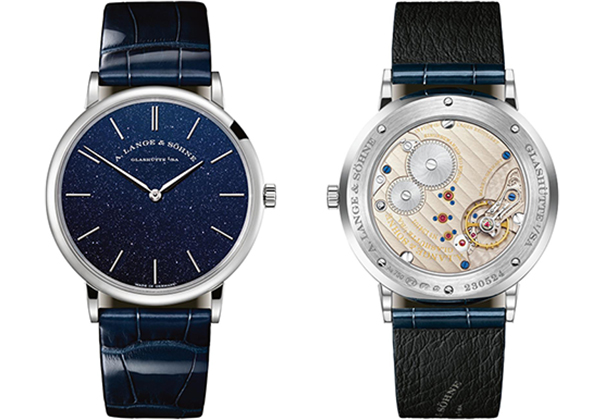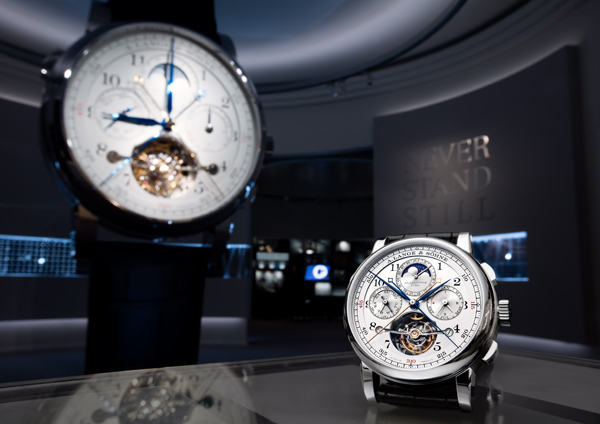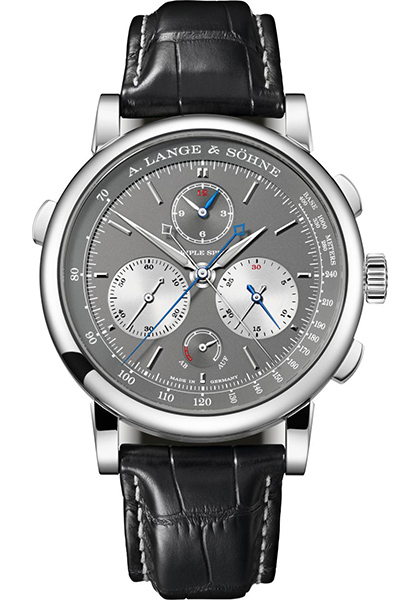A. Lange & Söhne is adding two pink-gold models to the 1815 Chronograph family. With the two new versions, watch connoisseurs are spoilt for choice: Featuring a black dial, hands that match the pink-gold case and a black alligator leather strap, the 1815 Chronograph has a harmoniously sculpted and distinctive silhouette. Thanks to the expressive combination of an argenté dial, blued-steel hands and a red-brown alligator strap, it is a functional understatement.
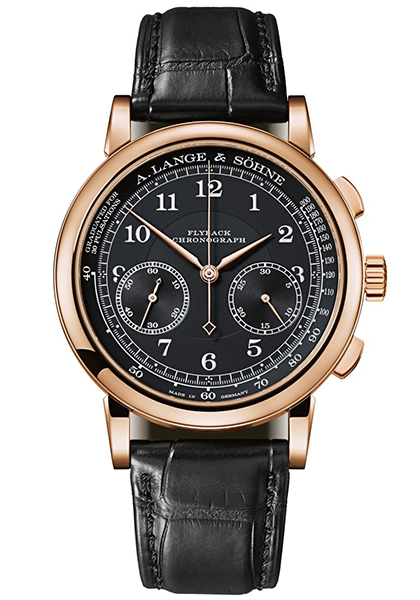
1815 Chronograph in pink gold with black dial and strap © A. Lange & Söhne
The slender chronograph sweep seconds hand is activated with a pusher at 2 o’clock. It indicates the time with a resolution of one-fifth of a second. The flyback function allows instant consecutive measurements: when the pusher at 4 o’clock is pressed, the chronograph’s seconds- and minute-counter hands jump to zero and then immediately restart to take a new measurement.
The peripheral pulsometer scale is reminiscent of a classic pocket watch function; it is used for heart rate measurements. This measures the time it takes to count 30 heartbeats. On the scale graduated from 40 to 200 beats, the chronograph sweep seconds hand indicates the heart rate in beats per minute.
The movement has 833 parts, housed within a densely decorated rose-gold case fitted with a seven-part tooth dial.The initials “JAP,” for Jules Audemars and Edward Piguet, founders of Audemars Piguet, appear about the gong block. Audemars Piguet may in fact have made not just the gongs however, the entire movement: in these days, it was common for European watch companies to buy raw motions from Swiss companies and finish them to their own specifications.The watch virtually dropped into oblivion. In 2001, a married couple brought it to Lange’s headquarters at Glashütte to find out whether it were worth repairing. A housekeeper they understood had received it as a gift over the usual half-century earlier. The answer was not obvious. In a book about the opinion that the company published in 2010, ” Lange watchmaker Jan Silva explained the watch’s state: “Where there could normally be a complex, delicate mesh of bridges, springs and brakes, there was nothing to be seen however a gray-brown, amorphous mass …. Just the larger components of the motion were still recognizable.” Silva led a team of four watchmakers that revived the motion to pristine state. It required five years; the dismantling process alone took three months.The watch’s case was made from the industrial developer Carl Ludwig Theodor Graff in the Louis XV style. The front bears an engraving of the goddess Minerva; the rear is adorned with all the initials “G.S.” No one knows whose initials they are. Contrary to the motion, the case and the dial had been in excellent condition when the watch resurfaced in 2001. The Grande Complication is currently on loan to the Mathematics and Physics Salon, a museum in Dresden dedicated to historic timepieces and scientific instruments.
One watch to rule them all…Having a wristwatch of those features on your hands or on your wrist, even if it’s only for a couple of minutes, makes it hard to maintain your journalistic objectivity complete. Please excuse me if the next article gets lyrical and enthusiastic… That is the effect that a watch such as the A. Lange & Söhne Triple Split can have to a watch lover. However, before that, I must ask a very simple question: Why Is your Triple Split useful? And the answer is: No! This watch has just no logical purpose. The Dual Split was already a demonstration of desirable inutility and the Triple Split follows the exact same path. Do not get me wrong, however. I say so with all due respect and a lot of affection. This watch is in the same vein as a Lamborghini Aventador SV or even a Bugatti Chiron. Impossible to use on the street yet oh-so-essential at the same moment. That being said, let us have a look at this bit of pure “watch eroticism”.What is a split? What is a double divide? And what’s more, what is a triple divide? Or in short, why is the ALS Triple Split THE most complicated chronograph ever created?Once upon a time, watchmakers made a tool named the chronograph — or even the stopwatch (using a lot of questions about who actually created it — Nicolas Rieussec or Louis Moinet). They were created in order to figure out the distance of an occasion, from its start to its end. Whether they are presently utilized to assess the cooking time of your own pasta or the length of a meeting, their first goal was to time races.
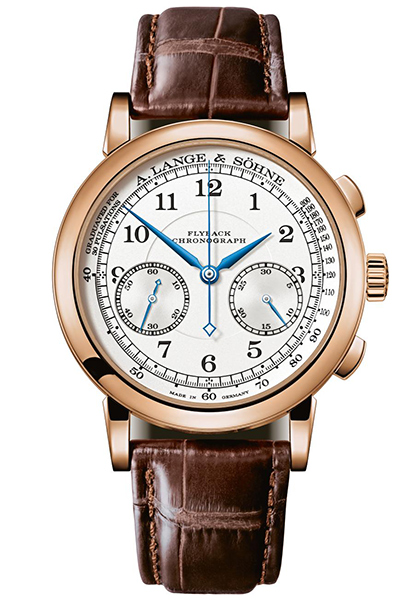
1815 Chronograph in pink gold with silver dial and brown strapelet brun © A. Lange & Söhne
That was the status quo until A. Lange & Söhne arrived on the market using a watch filmed by collectors that the “Mighty Double Split” or the “Über-Chronograph”, a timepiece with split seconds and split minutes. This season, in the SIHH 2018, A. Lange & Söhne presented the Triple Split, the “mighter than mighty” variant of its rattrapante chronograph. 1 opinion to rule them all…Using a watch of these characteristics on your hands or in your wrist, even if it’s just for a few minutes, makes it difficult to keep your journalistic objectivity complete. So please excuse me if the following article gets lyrical and enthused… That is the effect that a watch such as the A. Lange & Söhne Triple Split may have on a watch lover. But before that, I must ask a very simple question: Is your Triple Split useful? And the answer is: No! This watch has simply no rational function. The Dual Split was a demonstration of desired inutility along with the Triple Divide follows exactly the same path. Don’t get me wrong, though. I say so with all due respect and a lot of affection. This view is in Precisely the Same vein as a Lamborghini Aventador SV or a Bugatti Chiron. Impossible to work with on the street yet oh-so-essential in precisely the exact same time. What’s a double divide? And what’s more, what’s a triple split? Or in short, why is the ALS Triple Split THE most complicated chronograph actually created?Once upon a time, watchmakers made an instrument named the chronograph — or the stopwatch (using plenty of questions about who actually created it Nicolas Rieussec or even Louis Moinet). A chronograph is a watch for timing events. They were made in order to figure out the length of an occasion, from its start to its end. Whether they are presently used to assess the cooking period of your own pasta or the length of a meeting, their first goal was to period races.
Arabic numerals and the railway-track minute scale are hallmarks of the 1815 watch family that has combined classic design and mechanical ingenuity with optimised functionality since 1995. The symmetrically arranged subsidiary dials for the minute counter at 4 o’clock and the subsidiary seconds dial at 8 o’clock emphasise the balanced character of the timepiece. Two solid-gold push pieces with defined trigger points control the chronograph including the flyback function.
Exactly what the watch was lost than some perpetual calendar, was a moon-phase display and needless to say, a leap year index. Unlike a endless, the yearly calendar does not account for a Leap Year, therefore it must be adjusted once per year in the end of February (in both Leap Years and non-Leap Years; since we mentioned, the annual calendar just distinguishes between 30 and 31-day weeks).The automated grade 315 S-QA was the first ever annual calendar motion and has been made of 316 parts. (Photo: Courtesy Christie’s)Now, if you’re a diehard calendar fanatic (bless you), then re-setting your watch at the conclusion of each February might seem tedious, and if you therefore wish to splurge for the mac-daddy endless calendar complication — fine. If you are not, and you’re okay with the extra work that is required to find your setting snare (that always seems to go lost) and push a button, then the annual calendar is right for you — though with the Lange we’re going to enter, no trap is necessary.The ref. 5035 remained in production until 2005, when the mention 5146 was released because of its own successor. The yearly calendar disadvantage was, and is still, unique since it’s more accessible price-wise (together with the knowledge that “available” is a comparative term) while enabling those who wish to go into the world of complicated watches do so with dignity, and without having to sell their house or shed a spouse in the procedure. For Patek, the yearly calendar is a cornerstone product, also has been used in countless watches, from tasteful restricted variations to sporty chronographs in multiple guises.
A particular feature of Caliber L921, also called the Sax-0-Mat, is a zero-reset function for those seconds — thus the “0” at “Sax-0-Mat.” The small seconds hand automatically contributes to the zero position once the crown is pulled out, for to-the-second time setting. “Sax-0-Mat” appears on the Cable and dial. The caliber, which was hand-wound, 30.6 mm in diameter and 7.5 mm thick, was four years in development, and comprised a flyback function.Its unconventional features include another bridge to the fourth wheel, a chronograph operating lever mounted between two bearings, an adjustable coupling lever positioned in the middle of the wheel, plus a minute-counter-operating lever mounted involving jewels. There is also a stepped pinion for accurate minute-counter advances, an escape wheel with four stones, a large Glucydur screw balance and a Breguet balance spring. The balance oscillates in the classic frequency of 18,000 vph. The grade also supports Lange’s recognizable outsize date, where the prefix “Dato” alludes.Nowadays that this watch can be obtained since the Datograph Auf/Ab; the movement was improved and a power-reserve display was added. There is also a version with a perpetual calendar, the Datograph Perpetual.In the watchmaking world, there’s the chronograph complication — in itself a more intricate form of motion that’s tough to develop and also to assemble. Then, there’s the flyback chronograph, allowing for an instantaneous reset-start of the timing session. And for decades, right on top of the food chain was that the Split Seconds or rattrapante chronograph — the supreme version of the stopwatch.
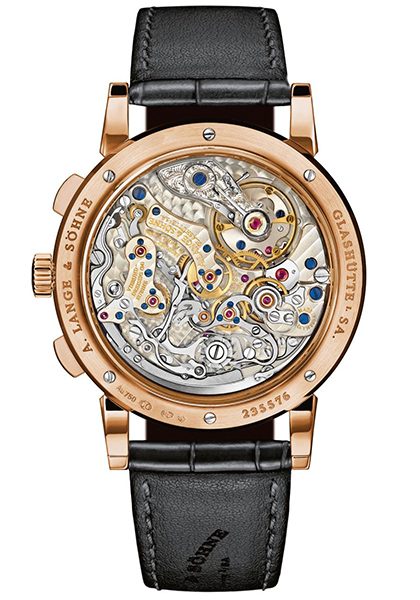
Case back view © A. Lange & Söhne
And from this lost confidence came Twelve Mistakes New Watch Guys Make, because, as you ought to know by now, the yearly calendar is a product of the 1990s. It could hardly drink! Really, the yearly calendar was created only 21 years back by Patek Phillippe, and first produced since the benchmark 5035. The notion, which was actually one of the earliest “mid-tier” complications to come out of a major brand, was a fantastic commercial measure for Patek, even if a bit ho-hum in terms of horological innovation. Instead of a simple calendar where one must manually adjust the date at the end of each month, the annual calendar compensates for all those months with 30 days. That would be an unbelievable accomplishment! That’s, obviously, had the perpetual calendar, that compensates for not only shorter weeks but also for all leap years, had not been widely utilised in horology for the better part of 2 centuries.Some dismiss it as a dumbed-down endless calendar, but that’s not to say it’s not a beneficial and welcome complication. The 5035 enabled Patek clients to get into complications without even entering the stratosphere of the price and complexity, of endless calendars, tourbillons, minute repeaters, or even chronographs — remember, at this time, Patek failed to create a automatic chronograph, also in the time, they did not even create a straight wound chronograph afterward, in house or differently. So, pickings for complex Pateks at the time were lean.
The manually wound calibre L951.5 movement has a power reserve of 60 hours and a freely oscillating balance spring paired with a cam-poised balance. The sapphire-crystal caseback reveals salient hallmarks of the lavishly finished chronograph movement. Among other things, it exposes the column wheel that controls the chronograph functions, the levers of the flyback mechanism and the snail of the precisely jumping minute counter. The hand-engraved balance cock also complements the typical quality features of this watch.

